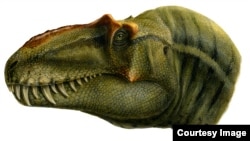Paleontologists say they have unearthed a new species of tyrannosaur in the western state of Utah.
The newly discovered dinosaur, the Lythronax argestes, belongs to the same evolutionary branch as the famous Tyrannosaurus rex. Lythronax argestes possesses several unique features, a short narrow snout with a wide back of the skull and forward-oriented eyes.
Lythronax translates as “king of gore,” and the second part of the name, argestes, refers to its geographic location in the American Southwest. Previously, paleontologists thought this type of wide-skulled tyrannosaurid only appeared 70 million years ago, whereas Lythronax shows it had evolved at least 10 million years earlier.
“The width of the back of the skull of Lythronax allowed it to see with an overlapping field of view—giving it the binocular vision— very useful for a predator and a condition we associate with T. rex,” said Dr. Mark Loewen, the study’s lead author.
Lythronax was approximately 8 meters long and weighed around 2.5 tons.
Lythronax lived on Laramidia, a landmass formed on the western coast of a shallow sea that flooded the central region of North America, isolating western and eastern portions of the continent for millions of years during the Late Cretaceous Period, between 95-70 million years ago. This landmass hosted a vast array of unique dinosaur species and served as the crucible of evolution for iconic dinosaur groups such as the horned and duck billed dinosaurs.
Scientists believe tyrannosaurids originated in northern Laramidia, with multiple species moving into southern Laramidia over time, and some species migrating to Asia towards the end of the Cretaceous.
Lythronax was discovered in Grand Staircase-Escalante National Monument, which encompasses 1.9 million acres of high desert terrain in south-central Utah.
The discovery was announced Wednesday in the open-access scientific journal PLoS ONE and unveiled on exhibit in the Past Worlds Gallery at the Natural History Museum of Utah at the Rio Tinto Center in Salt Lake City, Utah.
Here's a video about the discovery:
The newly discovered dinosaur, the Lythronax argestes, belongs to the same evolutionary branch as the famous Tyrannosaurus rex. Lythronax argestes possesses several unique features, a short narrow snout with a wide back of the skull and forward-oriented eyes.
Lythronax translates as “king of gore,” and the second part of the name, argestes, refers to its geographic location in the American Southwest. Previously, paleontologists thought this type of wide-skulled tyrannosaurid only appeared 70 million years ago, whereas Lythronax shows it had evolved at least 10 million years earlier.
“The width of the back of the skull of Lythronax allowed it to see with an overlapping field of view—giving it the binocular vision— very useful for a predator and a condition we associate with T. rex,” said Dr. Mark Loewen, the study’s lead author.
Lythronax was approximately 8 meters long and weighed around 2.5 tons.
Lythronax lived on Laramidia, a landmass formed on the western coast of a shallow sea that flooded the central region of North America, isolating western and eastern portions of the continent for millions of years during the Late Cretaceous Period, between 95-70 million years ago. This landmass hosted a vast array of unique dinosaur species and served as the crucible of evolution for iconic dinosaur groups such as the horned and duck billed dinosaurs.
Scientists believe tyrannosaurids originated in northern Laramidia, with multiple species moving into southern Laramidia over time, and some species migrating to Asia towards the end of the Cretaceous.
Lythronax was discovered in Grand Staircase-Escalante National Monument, which encompasses 1.9 million acres of high desert terrain in south-central Utah.
The discovery was announced Wednesday in the open-access scientific journal PLoS ONE and unveiled on exhibit in the Past Worlds Gallery at the Natural History Museum of Utah at the Rio Tinto Center in Salt Lake City, Utah.
Here's a video about the discovery:







